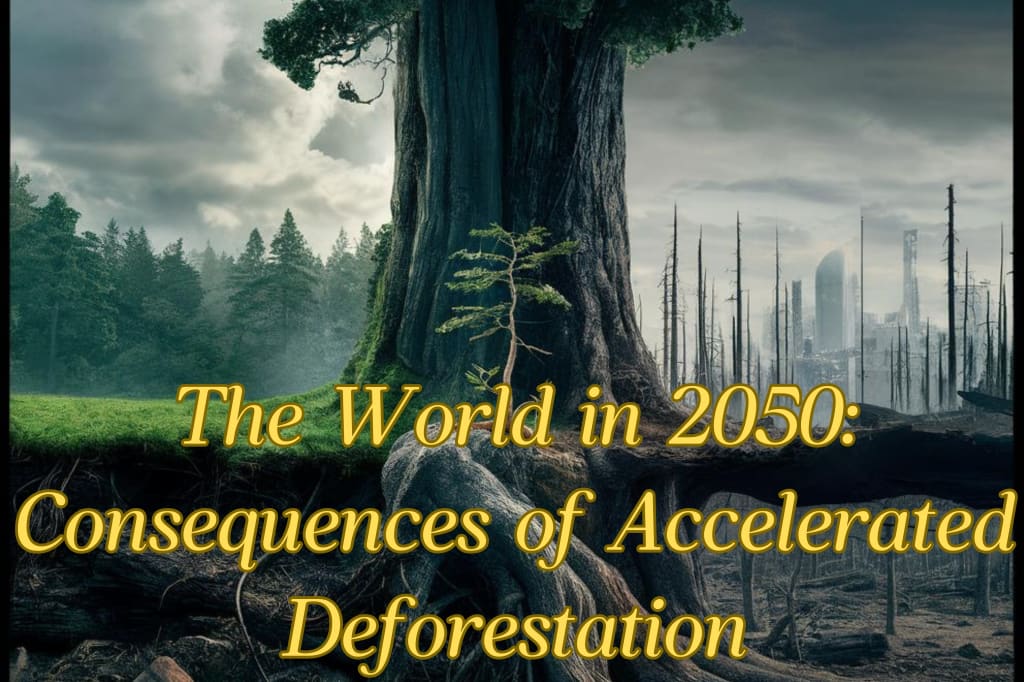Vanishing Canopies: The Perils of Accelerated Deforestation in 2050
A Global Crisis Unfolds: Biodiversity Loss, Climate Chaos, and Human Resilience.

In the year 2050, the world is grappling with the catastrophic consequences of accelerated deforestation, a relentless assault on our planet's vital forests that has irreversibly altered the Earth's landscape and ecosystems. What began centuries ago as a gradual depletion of woodlands for sustenance and industrial needs has morphed into a frenzied race to clear forests for agriculture, urbanization, and economic gain. This insatiable appetite for land and resources has unleashed a cascade of environmental, social, and economic challenges that threaten the very foundation of life on Earth.
### The Ecological Catastrophe Unfolds
At the heart of the crisis lies biodiversity loss on an unprecedented scale. As forests vanish at alarming rates, countless species teeter on the brink of extinction, their habitats fragmented and destroyed. The intricate web of life that evolved over millennia is unraveling before our eyes, with repercussions that reverberate across continents. Species that once thrived in lush forests are now confined to isolated pockets or vanish altogether, disrupting ecosystems and diminishing their ability to provide critical services such as carbon sequestration and water filtration.
### Climate Chaos Amplified
Deforestation exacerbates climate change, amplifying its destructive impact. Forests act as carbon sinks, absorbing vast amounts of carbon dioxide from the atmosphere. With fewer trees, carbon dioxide levels soar, intensifying the greenhouse effect and driving global temperatures to unprecedented highs. The consequences are stark: more frequent and severe heatwaves, droughts, floods, and storms ravage communities and infrastructure worldwide. Agricultural systems falter as shifting weather patterns and diminished water supplies jeopardize food security, exacerbating poverty and social unrest.
### Human Health at Risk
The toll on human health is equally severe. Deforestation disrupts ecosystems, bringing humans into closer contact with disease-carrying animals and vectors. Zoonotic diseases, once confined to remote forested areas, now spread rapidly across continents, fueling pandemics and straining healthcare systems to their limits. The COVID-19 pandemic of the early 21st century serves as a stark reminder of the devastating consequences of encroaching on wildlife habitats and biodiversity loss.
### Socioeconomic Implications
Economically, the impacts are profound and far-reaching. While deforestation may yield short-term gains in terms of timber extraction, agriculture, and urban expansion, the long-term costs are staggering. Ecosystem services essential for human well-being, such as clean water, fertile soils, and climate regulation, decline precipitously, jeopardizing livelihoods and exacerbating poverty. Indigenous communities, often reliant on forests for their cultural and economic survival, bear a disproportionate burden as their lands and traditional knowledge disappear.
### A Call to Action
Mitigating the devastating consequences of accelerated deforestation demands urgent and concerted action on a global scale. Governments, businesses, and civil society must collaborate to enact and enforce stringent policies that promote sustainable land use practices, protect remaining forests, and restore degraded ecosystems. Investing in reforestation initiatives, particularly in tropical regions rich in biodiversity, is crucial for enhancing resilience against climate change and preserving vital ecosystem services.
Empowering local communities, especially indigenous peoples who have stewarded forests for generations, is essential for achieving sustainable development goals and fostering resilient communities. Recognizing and respecting indigenous land rights, traditional knowledge, and cultural practices are fundamental to restoring balance between humans and nature.
### Envisioning a Sustainable Future
Looking ahead to 2050, the path forward is fraught with challenges but also opportunities for transformative change. By prioritizing biodiversity conservation, climate action, and equitable development, we can forge a future where forests thrive, ecosystems flourish, and humanity coexists harmoniously with nature. This vision requires bold leadership, innovative solutions, and a shared commitment to preserving our planet for future generations.
In conclusion, the consequences of accelerated deforestation in 2050 are profound and far-reaching, touching every aspect of life on Earth. By addressing the root causes of deforestation and embracing sustainable practices, we can mitigate its devastating impacts and chart a course toward a more resilient and sustainable future for all. The time to act is now, for the fate of our planet and future generations hangs in the balance.
About the Creator
Enjoyed the story? Support the Creator.
Subscribe for free to receive all their stories in your feed. You could also pledge your support or give them a one-off tip, letting them know you appreciate their work.





Comments
There are no comments for this story
Be the first to respond and start the conversation.